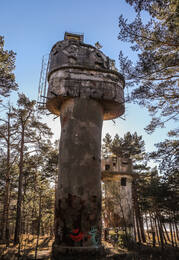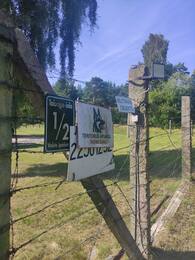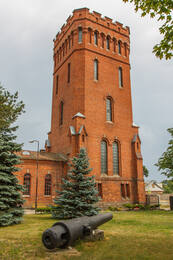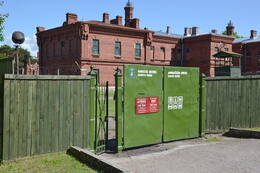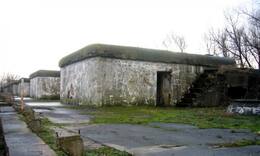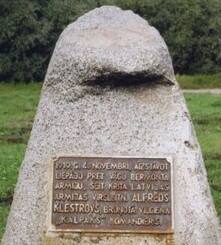Pirmasis pasaulinis karas ir nepriklausomybės kovos Pietų Latvijoje
Diena 1.
20 km
Diena praleista Liepojoje
Praktinė informacija
- Maršrutas skirtas kaip vadovas – kaip optimaliai keliauti po regioną ar šalį, arba dvi šalis, siekiant pažinti jų karinį paveldą;
- Vairuotojas turi pats suplanuoti – kiek iš rekomenduojamų objektų ir vietų jis gali apžiūrėti per vieną dieną;
- Prieš kelionę reikėtų pasitikrinti lankytinų vietų (muziejų, kolekcijų, įtvirtinimų ir kt.) darbo laiką;
- Vietose, kur reikalinga išankstinė registracija (vietiniai gidai, privačios kolekcijos, kitos), apsilankymą būtina užsisakyti, nurodant datą ir laiką. Jei kelionė atšaukiama, apie tai reikia informuoti užregistruotas vietas;
- Apgyvendinimą būtina užsisakyti iš anksto. Vasaros sezonu apgyvendinimo paslaugos gali būti neprieinamos, ypač pajūryje. Kai kurios maitinimo įstaigos žiemos sezonu gali nedirbti;
- Kelionei rinkitės ne tik vasarą, bet ir kitus metų laikus;
- Latvijos, Lietuvos ir Estijos sienas keliais galima laisvai kirsti be apribojimų ir bet kuriuo paros metu. Vykstant iš vienos šalies į kitą, būtina su savimi turėti asmens tapatybės kortelę arba pasą;
- Apsilankykite turizmo informacijos centruose, kur galite gauti papildomos informacijos, brošiūrų ir žemėlapių.
Lankytinos vietos
Karosta, Liepojos karinis uostas (ekskursija)
Karosta yra didžiausia istorinė karinė teritorija Baltijos šalyse ir užima beveik trečdalį visos Liepojos teritorijos. Karosta – unikalus karinių ir įtvirtinimų pastatų kompleksas Baltijos jūros pakrantėje, turintis ypatingą reikšmę Latvijos ir pasaulio istorijoje bei architektūroje. Karostoje yra tokie karinio paveldo objektai kaip Šiaurinis molas ir fortai, Redanas, Karostos kalėjimas, Karostos vandens bokštas, Šv. Nikolajaus stačiatikių Jūros katedra, Oskaro Kalpako tiltas ir kiti.
Redanas, Karosta
Redanas, arba Redanos fortas, yra Karostoje, lapkričio 14 d. gatvėje, apie 1,5 km nuo Šiaurinių fortų, gamtos rezervate „Tosmare“.
Istoriškai redanai buvo įtvirtinimų elementai, kur ilgesnės tvirtovės sienų atkarpos buvo dalijamos į trumpesnes dalis, įrengiant V formos pozicijas, nukreiptas į priešą, taip geriau apsaugant įtvirtinimų sieną. Karosto redanas yra XIX a. pabaigos Liepojos jūros tvirtovė, išsikišusi link Tosmarės ežero. Tvirtovei praradus savo, kaip tvirtovės, vaidmenį, aplink ją esantys įtvirtinimai ir fortai buvo iš dalies susprogdinti ir paversti nebenaudotinais. Tačiau Redanas išliko beveik nepaliestas.
1919 m. lapkritį, po nesėkmės Rygoje, Pavelo-Bermonto Avalovo pajėgos pradėjo intensyvų Liepojos puolimą. Mūšis vyko ir Redane, kur kovojo 80 Liepojos karinio uosto komendantūros kareivių, vadovaujamų vado leitenanto Radzinio. Lapkričio 14 d. per greitą puolimą bermontininkams pavyko užimti Redaną. Po to sekė Latvijos kariuomenės kontrataka ir Redanas buvo atsiimtas.
Birželio, liepos ir rugpjūčio mėnesiais kiekvieną dieną nuo 11.00 iki 17.00 val. Redane jūsų lauks patyręs gidas, pasiruošęs papasakoti daugiau apie Liepojos tvirtovę ir istorinius įvykius Karostoje.
Liepojos pakrantės artilerijos baterija Nr.2
Tarp daugelio Liepojos jūrų muziejaus eksponatų, Liepojos pakrantės artilerijos baterija Nr. 2 iki šiol yra paslaptingiausia vieta Liepojoje. Antrojoje baterijoje visada buvo įrengti įvairių valstybių karių šaudmenų sandėliai.
Liepojos tvirtovės 2-oji baterija buvo pastatyta toliau nuo pakrantės ir buvo apsaugota aukšta įtvirtinimų siena. Baterija buvo ginkluota 16 11 colių (280 mm) minosvaidžių, pagamintų 1877 m. modelio. Išardžius tvirtovę, čia buvo įrengti šaudmenų sandėliai. Dėl sprogimo pavojaus teritorija 130 metų buvo uždaryta visuomenei, saugoma, tačiau dabar čia įrengta paroda apie 1-ojo Kuršo divizijos štabo veiklą 1919–1940 m., taip pat eksponuojami 1-ojo Liepojos pėstininkų pulko, 2-ojo Ventspilio pėstininkų pulko ir Kuršo artilerijos pulko fotografiniai įrodymai.
Karostos vandens bokštas
Vandens bokštas yra Liepojoje, Karostoje, Generolo Baložos gatvėje 29 – ten, kur gatvė susikerta su Lazaretes gatve. Vandens bokštas buvo svarbus Karostos statinys, nes tiekdavo geriamąjį vandenį beveik visai Karostos teritorijai. Tikslus vandens bokšto statybos laikas nežinomas, tačiau jis galėjo būti pastatytas 1903–1905 metais. Projektą greičiausiai parengė Sankt Peterburgo architektas Stefanas Galenzovskis.
Vandens bokštą varė garo variklis su dviem anglimi kūrenamais katilais, vienas iš jų buvo laikomas rezerve, todėl šalia bokšto yra tokio pat aukščio kaminas. Transmisija varė keturis siurblius, iš kurių du buvo laikomi rezerve. Keturi gręžiniai tiekdavo vandenį siurbliams, kurie pumpuodavo jį į rezervuarą penktame bokšto aukšte, o iš ten – į karininkų butus ir kareivinių kareivines Karostoje.
Latvijos armijai perėmus vandens bokšto valdymą, vandens bokšto valdymą perėmė ir Karo ministerija. Po Antrojo pasaulinio karo valdymą perėmė Sovietų armija. Vandens bokštas uždarytas nuo 1989 m.
Nors bokštas nebuvo karinis statinys, 1919 m. lapkritį Latvijos armija atitaisė britų karo laivų artilerijos ugnį kovoje su Bermonto kariuomenės puolimu.
https://industrialheritage.travel/lv/objects/karostas-udenstornis/51
Liepojos tvirtovės baterija Nr.6
6-oji baterija, kuri šiandien yra geriausiai išsilaikęs įtvirtinimų statinys, buvo suplanuota Liepojos tvirtovės pakrantei į pietus nuo Prekybos kanalo apsaugoti. Baterijoje turėjo būti keturios 6 colių (152 mm) 1892 m. modelio „Canet“ sistemos patrankos, aštuonios 11 colių (280 mm) 1887 m. modelio patrankos, devyni įvairaus kalibro minosvaidžiai ir du 57 mm „Nordenfeld“ prieštankiniai pabūklai. Pirmojo pasaulinio karo pradžioje, tvirtovei jau esant išardytai, 6-ojoje baterijoje vis dar buvo ginkluotė, panaudota 1915 m. balandžio mėn., kai Vokietijos karinis jūrų laivynas bandė išsilaipinti prie Pietinio molo.
XX a. trečiojo dešimtmečio pradžioje baterijos vietoje pradėtas statyti Olimpijos stadionas, kurį galima pamatyti ir šiandien. Pietiniame baterijos gale iškastas įtvirtinimų griovys šiandien yra įtrauktas į Liepojos pajūrio parką.
Paminklas Latvijos armijos leitenantui Alfredui Klestrovui, šarvuotojo traukinio „Kalpaks“ mūšio vieta
Šarvuotojo traukinio vadas leitenantas leitenantas Alfredas Klestrovas, gimęs 1897 m. kovo 8 d. Liepojoje. Baigė Liepojos miesto mokyklą, vėliau – matininkų mokyklą Rygoje.
Pirmojo pasaulinio karo metu pašauktas į Rusijos armiją, baigė bataliono mokyklą Maskvoje. Tarnavo Rumunijos fronte, kovojo Ukrainoje. Kai Ukrainą okupavo vokiečių kariuomenė, grįžo į Rygą.
Ordinas buvo įteiktas 1922 m.
1919 m. pavasarį pašauktas į Latvijos kariuomenę, tarnavo papildomame 3-iosios Latgalos divizijos batalione. 1919 m. spalį paskirtas į šarvuotą traukinį „Kalpaks“ vadu.
1919 m. lapkričio 4 d., vokiečiams puolant Liepoją, šarvuoto traukinio „Kalpaks“ vadas leitenantas Alfredas Kliestrovas, apšaudomas sunkiąja artilerijos ir kulkosvaidžių ugnimi, surengė kontrataką ir su šarvuočiu traukiniu pateko į priešo užnugarį. Nesugebėjęs atidengti patrankų ugnies, jis vadovavo savo komandai durtuvų mūšyje ir išsklaidė priešą, taip prisidėdamas prie bermontiečių puolimo atsitraukimo, tačiau pats šiame mūšyje žuvo nuo vokiečių kareivių, kurie buvo įsitvirtinę namuose ir liko už Latvijos armijos kareivių nugaros, kulkos.
1935 metais Liepojos geležinkelio ir Liepojos-Grubinios plento sankryžoje, šarvuoto traukinio „Kalpaks“ vado leitenanto Alfredo Klestrovo žūties vietoje, buvo pastatyta atminimo lenta.
Vietos pavalgyti
Liepojoje žiūrėkite liepaja.travel
Vietos apsistoti
Liepojoje žiūrėkite liepaja.travel




